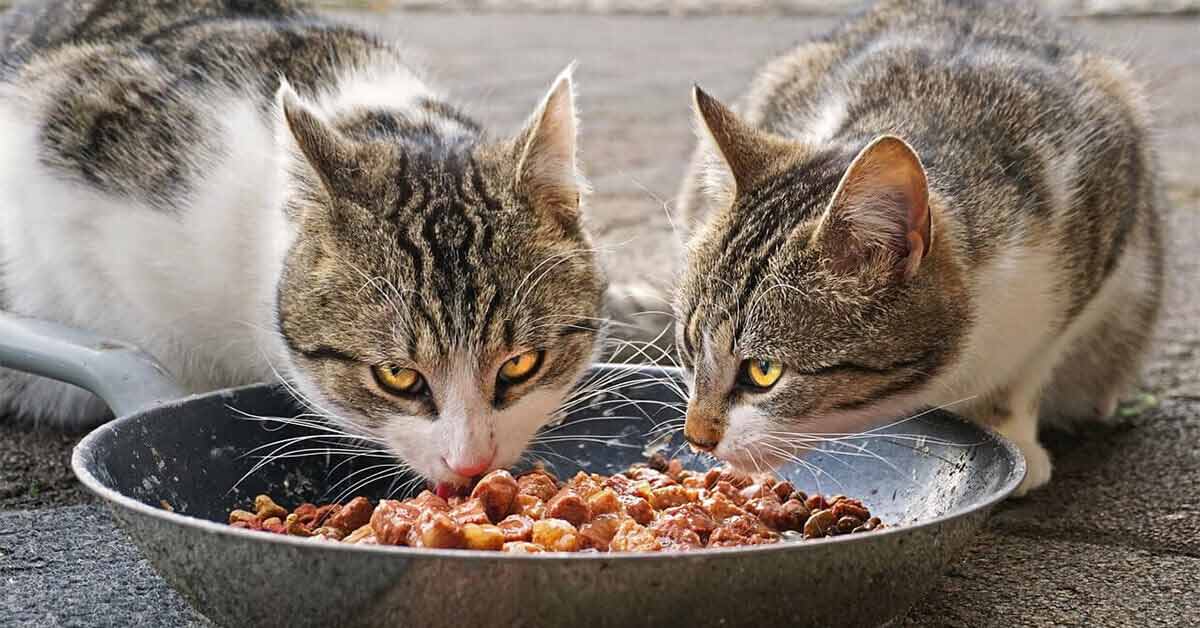4 Factors & 5 Charts – How Much Food Should a Cat Eat
Portion sizes and frequency are among the most important factors in determining how much food a cat should eat.
However, there are other indicators in play you should be aware of that are equally important to know.
So, let’s not waste anymore time and dive right into the details:
4 Factors That Determine How Much Food Does a Cat Need
These are the main indicators to feeding your cat and are paramount to ensure your purry baby is healthy and fit.
- Cat’s Age
- Cat’s Size
- Daily Activities
- General Lifestyle
Let’s start by discussing the most important factors that determine the portion ratio, such as your cat’s age, size, activities, and general lifestyle.
1. Age
Kittens, adult cats, and senior cats require different amounts of food as they grow up. Cats aren’t like dogs, in a way that you can pour as much food as you want into their bowls, and they’ll eat only enough to make them satiated.
Kittens, on the other hand, require less food. When they’re little they’ll eat as much as possible, unknowingly of course, that the food source will not grind to a halt.
Since they’re little, it means they haven’t learned that food is not scarce yet, so they’ll try to devour a lot. As they grow up, they’ll see that their bowls are always full, so they’ll ease out from eating a lot and will portion themselves up to meet their needs.
How Much Food to Feed a Cat by Age – Chart
| Age | Daily Calorie Intake | Feeding Frequency |
|---|---|---|
| Kitten | 250 to 500 | 3 to 4 meals per day |
| Adult | 200 to 300 | 2 meals per day |
| Senior | 180 to 220 | 2 to 3 smaller meals per day |
![How Much Food to Feed a Cat [By Age] IG2](https://purrfectlykiki.com/wp-content/uploads/2024/04/How-Much-Food-to-Feed-a-Cat-By-Age-IG2.jpg)
2. Size
The next thing to pay attention to is how big or small your cat is. Larger cats naturally require more food, while smaller ones may eat only what they need to fill their energy levels.
Weight control, no matter how that sounds, is something that you should pay attention to when it comes to your purry little friends. Being overweight is one thing, but being overweight and having lots of body fat might not be good for your cat’s overall health and well-being.
How Much Food to Feed a Cat by Size – Chart
| Weight in Kilograms | Kilocalories per Day |
|---|---|
| Up to 1 kg | 100 to 130 |
| 1 to 2 kg | 130 to 170 |
| 2 to 3 kg | 170 to 200 |
| 3 to 4 kg | 200 to 230 |
| 4 to 5 kg | 230 to 270 |
| 5 to 6 kg | 270 to 300 |
| 6 to 7 kg | 300 to 330 |
| Over 7 kg | 330 to 370 |
![How Much Food to Feed a Cat [By Size] IG1](https://purrfectlykiki.com/wp-content/uploads/2024/04/How-Much-Food-to-Feed-a-Cat-By-Size-IG1.jpg)
3. Activities
This is paramount as the activity levels dictate how much food a cat should eat. If your cat is very playful, they may require more food and more visits to the litter box.
However, if your cat doesn’t play a whole lot, and instead is laying down all day being lazy as they are, then you need to portion their food so they do not get too chonky.
With that in mind, take note of how many times your cat goes to the litter box each day and compare that to the number of times they play and eat throughout too.
4. Lifestyle
If you have an indoor cat, this means they burn fewer calories compared to an outdoor cat that ventures into playing, hunting, and constantly running around.
Don’t get us wrong, though, as there are many very active indoor cats out there. Our Kiki is one of them, as she’s an indoor cat and has plenty of fun activities she does on her own and with us as well throughout the day.
That said, it is important to pay attention to their lifestyle and ration cat food portions accordingly without worrying about over- or under-feeding them.
🐾 An excellent starting point is to increase the portion sizes as kittens grow into cats, while also paying attention to how active your purry friend is to ensure it doesn’t get too chonky and unhealthy.
How Much Food Should a Cat Eat – Basic Chart & Guidelines
When considering calorie intake, take note of the basic guidelines we’ve discussed above.
Additionally, there are various recommendations regarding exactly how many calories a cat should consume. Based on what our vets recommend, here’s a breakdown of kilocalories per weight for spayed/neutered cats and intact cats:
| Weight | Spayed/Neutered | Intact |
|---|---|---|
| Up to 1 kg | 90 calories per day | 130 calories per day |
| 1 to 2 kg | 130 calories per day | 170 calories per day |
| 3 to 4 kg | 160 calories per day | 200 calories per day |
| 4 to 5 kg | 190 calories per day | 230 calories per day |
| 5 to 6 kg | 230 calories per day | 270 calories per day |
| 6 to 7 kg | 260 calories per day | 300 calories per day |
| Over 7 kg | 320 calories per day | 370 calories per day |
![How Much Food to Feed a Cat [By Weight] IG3](https://purrfectlykiki.com/wp-content/uploads/2024/04/How-Much-Food-to-Feed-a-Cat-By-Weight-IG3.jpg)
How Much Dry Food to Feed a Cat Per Day – Chart
Dry food can be left out in the open for longer, which may come in handy if you are out throughout the day, and your cat can eat whenever they feel peckish.
You don’t have to worry about portion sizes with dry food as cats love it, so just replenish their bowls two to three times per day, and you’re good to go.
Here’s a closer look at the amount of dry food you should serve:
Dry Cat Food Portion Chart Per Age
| Age | Dry Food |
|---|---|
| Kitten | 50 to 75 grams |
| Adult | 40 to 60 grams |
| Senior | 30 to 40 grams |
![Dry Cat Food Portion Chart [Per Age]](https://purrfectlykiki.com/wp-content/uploads/2024/04/Dry-Cat-Food-Portion-Chart-Per-Age.jpg)
How Much Wet Food to Feed a Cat Per Day – Chart
Wet food, compared to dry food, has more moisture in its contents. This helps hydration, but if left out in the open for too long can go sour, and your cat won’t come back the second time to finish it.
However, wet food has more protein and taurine, and if you feed it regularly to your cat, you might notice aggression, buffiness, and a stickier fur. Therefore, if you decide to feed your cat wet food, make sure to portion it properly.
Here’s who to do it the right way:
Wet Cat Food Portion Chart Per Age
| Age | Wet Food |
|---|---|
| Kitten | 75 to 100 grams |
| Adult | 100 grams |
| Senior | 85 grams |
![Wet Cat Food Portion Chart [Per Age]](https://purrfectlykiki.com/wp-content/uploads/2024/04/Wet-Cat-Food-Portion-Chart-Per-Age.jpg)
Feeding Schedules
To keep your furry baby happy, healthy and well, and in good weight, be very mindful of the portion sizes. Many experts and veterinarians suggest purr-ents to establish specific meal times and portion sizes based on the cat’s age, weight, and lifestyle.
On the other hand, others suggest quite the opposite – leave food in the bowl and your cat will eat as much as it needs, not one bite more. Ultimately, how much food a cat should eat will also depend on their own character.
While calorie intake varies and purr-ents should pay attention to that, you can always test to see how your cat behaves with a specific plan or by leaving out food all day long.
What we have noticed in Kiki is that we leave food in her bowl throughout the day, and she eats only enough so she can have energy to play, run, and jump around. She isn’t overweight nor has body fat, in fact, she’s pretty muscle-y, strong, and healthy. Our vet always commends us every time we take her for a routine check-up.
🐾 If you opt to leave food for your cat throughout the day, make sure you refill their bowls multiple times, as opposed to leaving the food all day long for it to oxidize, possibly ruining it.
How Much Food Should a Kitten Eat a Day
Kittens require frequent but small, high calorie meals to support their growth. This means you should aim for about 60 to 65 calories per serving of body weight daily.
Take note of how your kitty behaves, as their natural instincts prevail over their logical functioning. What this means is that if you pour 4 full servings into their bowl instead of just 1, there’s a fairly strong chance your little kitty will eat the whole bowl.
As we mentioned earlier, they don’t know when the next serving will arrive as they haven’t yet developed that habit. So, be patient when your kitty meows at you for food, even though they’ve just eaten.
How Much Food Should an Adult Cat Eat a Day
An average adult cat weighs around 3.5 to 4 kilograms (about 8 pounds) and needs approximately 200 calories per day to maintain a healthy weight.
Before giving food to your cat, check the caloric density per cup, especially if you alter between dry and cat foods as they differ massively.
Cats often prefer to eat smaller meals multiple times throughout the day. So it’s best to refill their bowls a few times each day, such as in the morning, then in the afternoon, and, of course, in the evening.
How Much Food Should a Senior Cat Eat a Day
Cats older than seven years are considered senior cats, and at this point, your cat is ready for a senior cat recipe and routine.
As cats grow older, they slow down, so naturally, their diet needs to be accommodated to meet their calorie needs.
When you’re looking to select the right food, ensure it consists of lots of vitamins and minerals to help improve their muscles, heart, and overall immune system.
🐾 Our advice is to fill their bowls two to three times per day and let them eat as much as they want. Once they learn that there’s an endless supply of food, they’ll eat only the necessary amount.
Wrapping Up
These are the basic guidelines and workarounds on how much food a cat should eat. The main thing is to ensure your purry little baby remains healthy and strong as much as possible.
With that in mind, the charts above provide detailed info on portion sizes and frequency, depending on your cat’s age and lifestyle.
However, no need to preoccupy yourself with limits or specific schedules about meals. Simply, fill their bowls and watch their behavior to see which type of food they love most and get more from it.
We hope that this article has helped you better understand the calorie intake, feeding schedules, and portion sizes per servings so that your cat can enjoy a long and healthy life.

